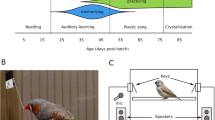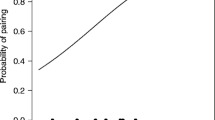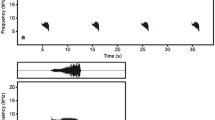Abstract
We studied the relative effects of early and late song exposure without social reinforcement on female sexual preferences in the domestic canary (Serinus canaria). Young female canaries were tape-tutored during their first 4 months of life with songs of either domestic or wild male canaries (DT and WT conditions). When they reached sexual maturity, these females were placed in breeding conditions and some of them were re-exposed to songs. During this “late exposure” the females, according to their experimental group, were either presented with new domestic or wild songs (DL and WL conditions) over 40 days, or were kept without song stimulation (− condition). Afterwards, we assessed the sexual preferences of all the females for domestic or wild songs using the copulation solicitation display assay. The results showed that both DT/– and DT/DL females showed a clear preference for domestic songs. However, whereas WT/WL females preferred wild songs; WT/– females did not show any preference. Finally, DT/WL and WT/DL females failed to show any preference. It appeared that a second song experience at the beginning of their first breeding season, without any social reinforcement, allowed the emergence or stabilisation of early preferences, or interfered with these early preferences depending on whether the song category used during the late exposure phase matched or not the song category used during the early tutoring phase, and also depending on which category was used during the first tutoring phase. This behavioural plasticity could help young adult females to adjust the ‘standard’ they built during infancy to new environmental conditions.



Similar content being viewed by others
References
Arnaiz-Villena A, Alvarez-Tejado M, Ruiz-del-Valle V, Garcia-de-la-Torre C, Varela P, Recio MJ, Martinez-Laso J (1999) Rapid radiation of canaries (genus Serinus). Mol Biol Evol 16:2–11
Baker MC (1983) The behavioral response of female Nuttall’s white-crowned sparrows to male song of natal and alien dialects. Behav Ecol Sociobiol 12:309–315
Baker MC, Spitler-Nabors KJ, Bradley DC (1981) Early experience determines song dialect responsiveness of female sparrows. Science 214:819–820
Baker MC, Bjerke TK, Lampe HU, Espmark YO (1987) Sexual response of female yellowhammers to differences in regional song dialects and repertoire sizes. Anim Behav 35:395–401
Béguin N, Leboucher G, Kreutzer M (1998) Sexual preferences for mate song in female canaries (Serinus canaria). Behaviour 135:1185–1196
Casey RM, Baker MC (1992) Early social tutoring influences female sexual response in white-crowned sparrows. Anim Behav 44:983–986
Catchpole CK, Slater PJB (1995) Birdsong. Biological themes and variations. Cambridge University Press, Cambridge
Clayton N (1988) Song discrimination learning in zebra finches. Anim Behav 36:1016–1024
Collins SA (1995) The effect of recent experience on female choice in zebra finches. Anim Behav 49:479–486
Depraz V, Leboucher G, Kreutzer M (2000) Early tutoring and adult reproductive behaviour in female domestic canary (Serinus canaria). Anim Cogn 3:45–51
Eastzer DH, King AP, West MJ (1985) Patterns of courtship between cowbird subspecies: evidence for positive assortment. Anim Behav 33:30–39
Follett BK, Hinde RA, Steel E, Nicholls TJ (1973) The influence of photoperiod on nest-building, ovarian development and luteinizing hormone secretion in canaries (Serinus canarius). J Endocrinol 52:151
Gil D, Gahr M (2002) The honesty of bird song: multiple constraints for multiple traits. Trends Ecol Evol 17:133–141
Goldsmith AR, Burke S, Prosser JM (1984) Inverse changes in plasma prolactin and LH concentrations in female canaries after disruption and reinitiation of incubation. J Endocrinol 103:251–256
Hinde RA, Steel E (1976) The effect of male song on an estrogen-dependant behavior pattern in the female canary (Serinus canarius). Hormones Behav 7:293–304
King AP, West MJ (1977) Species identification in the north american cowbird: appropriate responses to abnormal song. Science 195:1002–1004
Kreutzer ML, Vallet EM (1991) Differences in the responses of captive female canaries to variation in conspecific and heterospecific songs. Behaviour 117:106–116
Kruijt JP, Ten Cate CJ, Meeuwissen GB (1983) The influence of siblings on the development of sexual preferences of male zebra finches. Dev Psychobiol 16:233–239
Leboucher G, Kreutzer M, Dittami, J (1994) Copulation-solicitation displays in female canaries (Serinus canaria): are oestradiol implants necessary? Ethology 97:190–197
Leitner S, Voigt C, Gahr M (2001) Seasonal changes in the song pattern of the non-domesticated island canary (Serinus canaria), a field study. Behaviour 138:885–904
MacDougall-Shackleton SA, MacDougall-Shackleton EA, Hahn TP (2001) Physiological and behavioural responses of female mountain white-crowned sparrows to natal- and foreign-dialects songs. Can J Zool 79:325–333
Marler P, Tamura M (1962) Song ‘dialects’ in three populations of white-crowned sparrows. Condor 64:368–377
Marler P, Tamura M (1964) Culturally transmitted patters of vocal behavior in sparrows. Science 146:1483–1486
Miller DB (1979a) The acoustic basis of mate recognition by female zebra finches (Taeniopygia guttata). Anim Behav 27:376–380
Miller DB (1979b) Long-term recognition of father’s song by female zebra finches. Nature 280:389–391
Morton ML (1992) Effects of sex and birth date on premigration biology, migration schedules, return rates and natal dispersal in the mountain white-crowned sparrow. Condor 94:117–133
Morton ML, Orejuela JE, Budd SM (1972) The biology of immature mountain white-crowned sparrows (Zonotrichia leucophrys oriantha) on the breeding ground. Condor 74:423–430
Mota PG (1995) Ecologia comportamental da reprodução no serino (Serinus serinus Aves: Fringillidae). PhD thesis, University of Coimbra, Portugal
Mundinger PC (1995) Behaviour-genetic analysis of canary song: inter-strain differences in sensory learning, and epigenetic rules. Anim Behav 50:1491–1511
Mundinger PC (1999) Genetics of canary song learning: Innate mechanisms and other neurobiological considerations. In: Konishi M, Hauser M (eds) The design of animal communication. MIT, Cambridge, Mass., pp 368–389
Nagle L, Kreutzer ML (1997a) Adult female domesticated canaries can modify their song preferences. Can J Zool 75:1346–1350
Nagle L, Kreutzer ML (1997b) Song tutoring influences female song preferences in domesticated canaries. Behaviour 134:89–104
Nottebohm F, Nottebohm ME, Crane L (1986) Developmental and seasonal changes in canary song and their relation to changes in the anatomy of song-control nuclei. Behav Neural Biol 46:445–471
O’Loghlen AL, Beecher MD (1999) Mate, neighbour and stranger songs: a female song sparrow perspective. Anim Behav 58:13–20
Riebel K (2000) Early exposure leads to repeatable preferences for male song in female zebra finches. Proc R Soc Lond B 267:2553–2558
Riebel K (2003) Developmental influences on auditory perception in female zebra finches—is there a sensitive phase for song preference learning? Anim Biol 53:73–87
Searcy W (1992) Measuring responses of female birds to male song. In: McGregor PK (ed) Playback and studies of animal vommunication. Plenum, New York, pp 175–189
Searcy WA, Peters S, Marler PR (1981) A test for responsiveness to song structure and programming in female sparrows. Science 213:926–928
Siegel S, Castellan NJ (1988) Nonparametric statistics for the behavioral sciences, 2nd edn. McGraw-Hill, New York
Specht R (1990–2002) Avisoft-SASLab Pro: sound analysis and synthesis laboratory. Avisoft, Berlin
Spitler-Nabors KJ, Baker MC (1983) Reproductive behavior by a female songbird: differential stimulation by natal and alien dialects. Condor 85:491–494
ten Cate C (1982) Behavioural differences between zebra finch and Bengalese finch (foster) parents raising zebra finch offspring. Behaviour 81:52–172
ten Cate C (1984) The influence of social relations on the development of species recognition in zebra finch males. Behaviour 91:263–285
ten Cate C (1994) Perceptual mechanisms in imprinting and song learning. In: Hogan JA, Bolhuis JJ (eds) Causal mechanisms of behavioural development. Cambridge University Press, Cambridge, pp 116–146
ten Cate C, Mug G (1984) The development of mate choice in zebra finch females. Behaviour 90:125–150
West MJ, King AP, Eastzer DH, Staddon JER (1979) A bioassay of isolate cowbird song. J Comp Physiol Psychol 93:124–133
Acknowledgements
We thank Stefan Leitner and Cornelia Voigt (Max Planck Institüt, Seewiesen, Germany) who kindly provided us with songs of wild canaries. The experiments comply with the French laws on the use of animals in research. We are also grateful to the anonymous referees for their useful comments on previous versions of the manuscript.
Author information
Authors and Affiliations
Corresponding author
Additional information
Communicated by P.K. McGregor
Rights and permissions
About this article
Cite this article
Depraz, V., Kreutzer, M. & Leboucher, G. Sexual preferences for songs in female domestic canaries (Serinus canaria): can late song exposure, without social reinforcement, influence the effects of early tutoring?. acta ethol 6, 73–78 (2004). https://doi.org/10.1007/s10211-004-0088-y
Received:
Revised:
Accepted:
Published:
Issue Date:
DOI: https://doi.org/10.1007/s10211-004-0088-y




